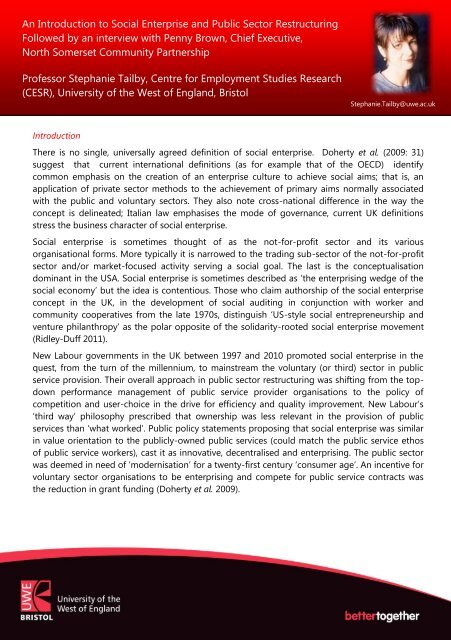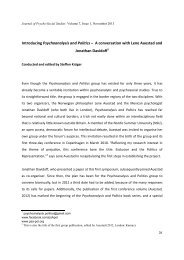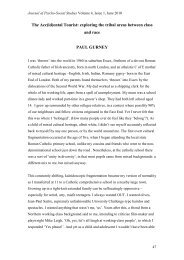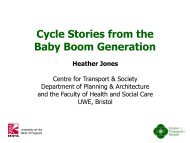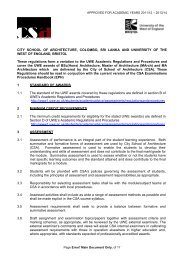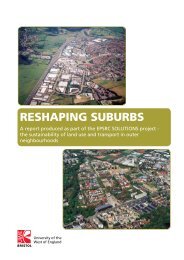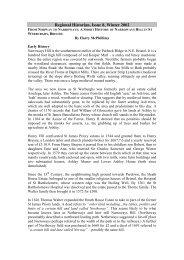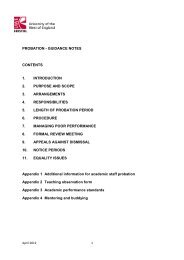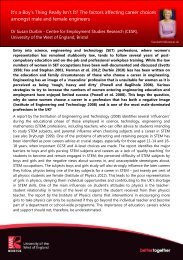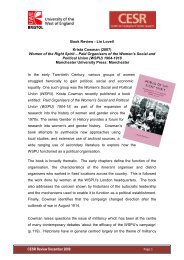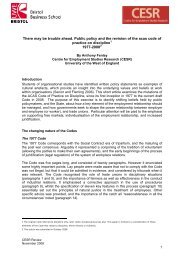An Introduction to Social Enterprise and Public Sector Restructuring ...
An Introduction to Social Enterprise and Public Sector Restructuring ...
An Introduction to Social Enterprise and Public Sector Restructuring ...
Create successful ePaper yourself
Turn your PDF publications into a flip-book with our unique Google optimized e-Paper software.
The definition now most commonly cited in public policy discussion of social enterprise in the UKwas developed by the <strong>Social</strong> <strong>Enterprise</strong> Unit that was created in the Department of Trade <strong>and</strong>Industry in 2001.... business with primarily social objectives whose surpluses are principally reinvested for thatpurpose in the business or in the community, rather than being driven by the need <strong>to</strong>maximise profit for shareholders <strong>and</strong> owners (DTI 2002).It does not prescribe that social enterprise need <strong>to</strong> operate on entrepreneurial principles. ForMiller <strong>and</strong> Millar (2011:3) social enterprise , encompassed ‘the various organisational forms thatin the UK were staking their claim <strong>to</strong> the emerging social enterprise agenda, which includedmembers of the cooperative <strong>and</strong> voluntary sec<strong>to</strong>rs as well as for profit businesses with a socialpurpose’. Equally it has been sufficiently loose <strong>to</strong> generate widely varying estimates of thenumbers of social enterprises currently trading in the UK, although government usually cites theOffice for the Third Sec<strong>to</strong>r estimate for 2006 of 55,000 with a combined turnover of £27bn.A legal form was instituted for social enterprise that in the UK had not previously had one,namely that of the community interest company (CIC): a limited liability company which carrieson a social activity, must be able <strong>to</strong> generate surpluses <strong>to</strong> support its activities, maintain itsassets, makes its contribution <strong>to</strong> the community <strong>and</strong> in some cases can make limited returns <strong>to</strong>the inves<strong>to</strong>rs (Office for the Regula<strong>to</strong>r, cited in Doherty et al. 2009: 38). The Office for the ThirdSec<strong>to</strong>r from 2006 had responsibility for pushing forward the government’s agenda for the sec<strong>to</strong>r(the DTI’s 2002 social enterprise: a strategy for success). Its action plan included improved advice<strong>and</strong> support, ways of removing barriers in the access <strong>to</strong> finance <strong>and</strong> ways of developingmanagement expertise within social enterprise requisite.In respect <strong>to</strong> the NHS, New Labour by the mid-2000s was defining government’s role ascommissioner rather than provider of services. Sir Nigel Crisp, then NHS Chief Executive,proposed a need for entrepreneurial leadership. Miller <strong>and</strong> Millar (2011) record how that themeof ‘intrapreneurs’ was extended in the White Paper Our health, our care, our say – a new directionfor community services (Department of Health 2006) <strong>to</strong> embrace staff setting up their ownbusinesses in the form of social enterprise. Action was promised <strong>to</strong> address barriers <strong>to</strong> socialenterprise formation – staff concerns about their future employment security <strong>and</strong> that of theirNHS pension – <strong>and</strong> a <strong>Social</strong> <strong>Enterprise</strong> Investment Fund was introduced <strong>to</strong> support theestablishment of new enterprises <strong>and</strong> encourage existing ones <strong>to</strong> extend within health care.Twenty-six Pathfinders were announced in 2007 <strong>and</strong> provided funding among other support. The2008 Darzi Review (Department of Health 2008) also concluded in favour of social enterprise,with a new emphasis on the goal of staff engagement through empowerment, <strong>and</strong> led <strong>to</strong> theintroduction a staff Right <strong>to</strong> Request <strong>to</strong> set up social enterprise. The 2009 TransformingCommunity Services programme obliged Primary Care Trusts <strong>to</strong> separate their provider <strong>and</strong>commissioning wings <strong>and</strong> find a new home for the former by 2012. <strong>Social</strong> enterprise was amongthe possible organisational forms. However, the context was not the most conducive for risktaking.The NHS was a principal beneficiary of New Labour’s investment in public services. <strong>Public</strong>expenditure retrenchment seemed the prospect in the light of the deficit accumulated in the2007/8 banking crisis <strong>and</strong> government efforts <strong>to</strong> counter economic depression.The Coalition government that formed after the May 2010 general election has pursued publicsec<strong>to</strong>r reform <strong>and</strong> rapid deficit reduction through public expenditure austerity. The idea of a ‘bigsociety’ alternative <strong>to</strong> state sec<strong>to</strong>r provision has struggled <strong>to</strong> excite support. The radical reformsof the NHS were trailed as having the aim of creating the largest social enterprise sec<strong>to</strong>r in theworld. Yet hospitals have been obliged <strong>to</strong> convert <strong>to</strong> foundation trust status, which is at oddsPage | 2
with the principle that social enterprise is a voluntary, civil society creation (OECD 2006 inDoherty et al. 2009: 30). The proposal that competition for service contracts should be among‘any qualified provider’ provoked clinicians’ dissent on the grounds that quality <strong>and</strong> efficiencyimprovement from integrated health care would be obstructed. It remains <strong>to</strong> be seen whethersocial enterprise is on a level playing field <strong>to</strong> compete for service contracts with private sec<strong>to</strong>rmultinational enterprise (Bach 2012).ReferencesBach, S. (2012) ‘Shrinking the state or the Big Society? <strong>Public</strong> service employment relations in anera of austerity’, Industrial Relations Journal, 43:5, 399-415Bach, S. <strong>and</strong> Kessler, I. (2012) The Modernisation of the <strong>Public</strong> Services <strong>and</strong> Employee Relations:Targeted Change, Palgrave Macmillan.Department of Health (2008) High Quality Care for All – NHS Next Stage Review Final Report.Stationery Office, LondonDepartment of Trade <strong>and</strong> Industry (2002) <strong>Social</strong> enterprise: a strategy for success. LondonDoherty, B., Forster, G., Mason, C., Meehan, J., Meehan, K., Rotheroe, N. <strong>and</strong> Royce, M. (2009)Management for <strong>Social</strong> <strong>Enterprise</strong>. Sage.Miller, R. <strong>and</strong> Millar, R. (2011) <strong>Social</strong> enterprise spin-outs from the English health service: a Right<strong>to</strong> Request but was anyone listening? Third Sec<strong>to</strong>r Research Centre Working Paper 52Ridley-Duff, R. (2011) Is it time for the <strong>Social</strong> <strong>Enterprise</strong> Mark Company <strong>to</strong> become a mutual?<strong>Social</strong> Yorkshire <strong>and</strong> Humber (SEYH)Page | 3
In conversation with Penny Brown, Chief Executive,North Somerset Community PartnershipProfessor Stephanie Tailby, Centre for Employment Studies Research(CESR), University of the West of Engl<strong>and</strong>, Bris<strong>to</strong>lAbout Penny BrownPenny Brown joined the NHS in 1989, starting in HR in Mental Health before moving in<strong>to</strong>general management in an Acute Trust <strong>and</strong> in<strong>to</strong> Community Services in 2007. The Labourgovernment’s Transforming Community Services (TCS) agenda in 2010 obliged PrimaryCare Trusts <strong>to</strong> separate their provider <strong>and</strong> purchasing arms <strong>and</strong> providers <strong>to</strong> find anotherorganisational form. Penny explained the options that were available <strong>and</strong> why the decisionwas made <strong>to</strong> enter a Right <strong>to</strong> Request <strong>to</strong> become a <strong>Social</strong> <strong>Enterprise</strong> <strong>and</strong> launch NorthSomerset Community Partnership.“What was the context <strong>and</strong> motive for becoming a social enterprise?Primary Care Trusts were commissioners <strong>and</strong> providers, a bit like GPs are now. The government’sagenda was <strong>to</strong> separate that <strong>and</strong> <strong>to</strong> have a clear line between them. So we needed <strong>to</strong> findanother organisation, either <strong>to</strong> go in<strong>to</strong>, or set up on our own.Some community services became part of a Foundation Trust. There was a debate whether weshould link in with our local secondary care provider, Wes<strong>to</strong>n Trust, <strong>and</strong> if we did that, would thatenable them <strong>to</strong> become a Foundation Trust? But both before we became a <strong>Social</strong> <strong>Enterprise</strong> <strong>and</strong>latterly, the business case didn’t stack up, whether we were in or out.We engaged with stakeholders <strong>and</strong> looked at three options. One was <strong>to</strong> link in with Wes<strong>to</strong>n. Theconcern, particularly from people at the north of our patch which fronts with the SuspensionBridge, was that it seemed a long way away. Would the services become <strong>to</strong>o Wes<strong>to</strong>n-centric? Asecond option was <strong>to</strong> link in with Bris<strong>to</strong>l Community Services (who also became a <strong>Social</strong><strong>Enterprise</strong>) <strong>and</strong> become a bigger <strong>Social</strong> <strong>Enterprise</strong>. Therewas a similar consideration: people in the south of thepatch, by Wes<strong>to</strong>n hospital, didn’t want <strong>to</strong> go in<strong>to</strong> Bris<strong>to</strong>l.Certainly from a patient perception <strong>and</strong> from the patientgroups <strong>and</strong> the community in general, there was a greatwish for us <strong>to</strong> be a North Somerset organisation <strong>and</strong> sothe only option really was for us <strong>to</strong> set up as a <strong>Social</strong><strong>Enterprise</strong>.We had <strong>to</strong> make sure we had arobust business case. <strong>An</strong>d Icould see the direction of travelwas for fewer people <strong>to</strong> begoing in<strong>to</strong> hospitalWe had <strong>to</strong> make sure we had a robust business case. <strong>An</strong>d I could see the direction of travel wasPage | 4
for fewer people <strong>to</strong> be going in<strong>to</strong> hospital. I thought that community services would be growing.So it stacked up as a business case model.When did the Right <strong>to</strong> Request policy start?It opened a lot earlier than the actual Transforming Community Services agenda. But at that pointit didn’t au<strong>to</strong>matically guarantee your contract. As part of the encouragement <strong>to</strong> become a <strong>Social</strong><strong>Enterprise</strong>, you’ll have <strong>to</strong> be offered a 3 <strong>to</strong> 5 year contract, which is very attractive.That was still under New Labour?Yes. But when there was a change of government the Coalition indicated they wanted <strong>to</strong> continue<strong>and</strong> we all had <strong>to</strong> be signed off. In fact we were all supposed <strong>to</strong> be separated by April 2011, butwe didn’t actually separate until Oc<strong>to</strong>ber.Could you tell me a bit about North Somerset Community Partnership as it exists now? What areado you serve?Our population is about 205,000. We have 26 GP practices <strong>and</strong> since we set up as a <strong>Social</strong><strong>Enterprise</strong>, we’ve reorganised ourselves in<strong>to</strong> five business units, one dealing with people withlearning disabilities, which in fact is a joint service with the Council. Our biggest is CommunityTeams <strong>and</strong> Wards, which is the District Nurses, Physiotherapists, Occupational Therapists. <strong>An</strong>d wehave Clevedon Community Hospital, a range of specialist services <strong>and</strong> some children’s serviceswhere the <strong>Public</strong> Health Nurses are employed.I think we’re the largest non-public sec<strong>to</strong>r employer in North Somerset. Our budget is £23million. We employ 550 staff, of which 360 are shareholders. We decided <strong>to</strong> make shareholdingoptional <strong>and</strong> that’s <strong>to</strong> test commitment <strong>to</strong> the organisation. We had <strong>to</strong> set up a <strong>Social</strong> <strong>Enterprise</strong>as part of the TCS agenda. It wasn’t everybody’s wish. We had <strong>to</strong> go somewhere <strong>and</strong> so I thoughtit would be helpful just <strong>to</strong> see, gauge the temperature by inviting people <strong>to</strong> becomeshareholders.The shareholding is nominal in amount: a £1 share. But it gives staff a right <strong>to</strong> vote for thingswhich is important. <strong>An</strong>d we’ve now recently become a member of the Employee OwnersAssociation <strong>and</strong> I think this is the strategy we really want <strong>to</strong> develop, really make shareholdersfeel as though they are shareholders <strong>and</strong> able <strong>to</strong> have their say in the way the organisation goesforward.<strong>Social</strong> <strong>Enterprise</strong> is about having social objectives <strong>and</strong> re-investment of any surplus.I mean essentially we are still a private organisation. We want <strong>to</strong> make profit, but that profit is reinvestedin<strong>to</strong> social benefit.<strong>An</strong>d you’re a Community Interest Company?Yes, it is a particular vehicle, although you can havedifferent sorts of community interest companies. Idefinitely wanted <strong>to</strong> have staff engagement. Thatwas paramount for me <strong>and</strong> so we chose <strong>to</strong> be aCommunity Interest Company, limited by shares soI mean essentially we are still aprivate organisation. We want <strong>to</strong>make profit, but that profit is reinvestedin<strong>to</strong> social benefitthat it was like John Lewis – <strong>and</strong> you know all that? We could have been a mutual. We evenlooked at being a charity. But all in all, we decided that a Community Interest Company withshareholders would be the best vehicle for us <strong>to</strong> meet our strategic aims of really getting thatstaff engagement in the services we provide.Page | 5
What about governance?We’ve got a Staff Council. Ten members of it are on our Council of Governors which also includesthree Community Forum representatives, so that we’re actually hearing the voice of thecommunity. We’ve got two provider GPs <strong>and</strong> then we have representatives from North SomersetCouncil <strong>and</strong> Wes<strong>to</strong>n Trust, as our local stakeholders.Did you see social enterprise as an opportunity? Did you have fears?There is opportunity. NHS funding is reducing <strong>and</strong> so I guess whereas I thought that we mightgain bigger contracts, I think now what we need <strong>to</strong> do - are having <strong>to</strong> do - is use our <strong>Social</strong><strong>Enterprise</strong> status, as a private organisation rather than part of the NHS, <strong>to</strong> capitalise on otherinvestment routes, other ways of attracting money. That could be through grants or it could bethrough developing fee services or by offering training; things that normally, as an NHSorganisation, we wouldn’t charge for so that we can generate income that way.What sort of risks did you think of at the time?The staff were looking <strong>to</strong> me <strong>to</strong> not be sailingthem up a wrong river. So I had <strong>to</strong> be confidentthat the business case stacked up, thesustainability of the organisation, <strong>and</strong> that wasquite a big commitment. You know, even sincewe set up as an organisation, things from aThe staff were looking <strong>to</strong> me <strong>to</strong> notbe sailing them up a wrong river. SoI had <strong>to</strong> be confident that thebusiness case stacked up…funding point of view have deteriorated, so that’s always a worry. Money is always a worry. Also,it’s getting staff on board with the ethos <strong>and</strong> believing it’s not just because we are a newst<strong>and</strong>alone organisation that things are <strong>to</strong>ugh, that that would be happening in any organisationproviding NHS services. If things start <strong>to</strong> go wrong <strong>and</strong> there are budget constraints <strong>and</strong> you’vejust set up a new organisation, people au<strong>to</strong>matically think ‘oh, it’s because it’s a neworganisation’ rather than this would be happening because we’re providing NHS services <strong>and</strong> theNHS currently is cash-strapped.We have the one main contract. It was negotiated in April 2010 for four years. It was novated [i.e.the new contract was substituted for the old one] when we set up <strong>and</strong> then it is novated everyApril. That goes on until the end of March 2015. I guess my worry now - procurement under theCoalition has become far more, everything is procured. So whereas I was hoping that our contractwould roll over, I realise that before the end of March 2014 we’ll have <strong>to</strong> be in procurement <strong>to</strong>get our contract back again. So a lot of time is spent on writing bids. It’s something that really, asNHS staff, we haven’t been exposed <strong>to</strong> in the way that the Virgins <strong>and</strong> the Sercos have becausethat’s their bread <strong>and</strong> butter. So it’s a whole new skill set that we have <strong>to</strong> invest in <strong>and</strong> acquire<strong>and</strong> it takes a lot of time <strong>and</strong> resources.A piece of King’s Fund research investigated motives for social enterprise - resignation <strong>to</strong> thesituation, positive aspirations for setting up. Where do you think you sat?I personally had positive aspirations. I think that some of our staff, particularly those who haven’tchosen <strong>to</strong> become a shareholder, are in the resignation camp, ‘this was just something that had<strong>to</strong> happen’. There are staff who just want <strong>to</strong> come <strong>to</strong> work <strong>and</strong> provide patient care which is very,very laudable, but probably won’t maximise the ability that we have now as a <strong>Social</strong> <strong>Enterprise</strong>.This is why our strategy for the year coming is <strong>to</strong> engage as much as we can with staff <strong>to</strong> get thatemployee ownership ethos, so that staff can take pride that we are a <strong>Social</strong> <strong>Enterprise</strong> <strong>and</strong>maximise the flexibilities that gives us.Page | 6
I think there is a difference between organisations that became <strong>Social</strong> <strong>Enterprise</strong>s under TCS, <strong>and</strong>those who chose <strong>to</strong> be a <strong>Social</strong> <strong>Enterprise</strong> when Right <strong>to</strong> Request was first launched. We linkquite closely with two other <strong>Social</strong> <strong>Enterprise</strong>s, both of which chose <strong>to</strong> be a <strong>Social</strong> <strong>Enterprise</strong> asopposed <strong>to</strong> doing it because they had <strong>to</strong> make a choice. I think in a way, they have greater staffengagement because at the time there was a genuine choice, whereas for us, there wasn’t. It wasa choice of three things none of which was staying as you are.I under<strong>to</strong>ok at the time not <strong>to</strong> change terms <strong>and</strong> conditions <strong>and</strong> I haven’t. We are looking atbenefits, we have introduced some. We haven’t changed any terms <strong>and</strong> conditions. There wereother things more important <strong>and</strong> I wanted <strong>to</strong> keep staff on board.You’ve emphasised staff engagement <strong>and</strong> ownership. What other mechanisms are there for staff <strong>to</strong>be involved?We have set up an ideas fac<strong>to</strong>ry. We have ourstaff awards. We have regular away-days wherepeople can put forward ideas for how theydevelop their services. In terms of the businessmanagers, all NHS organisations have got <strong>to</strong>make efficiency savings <strong>and</strong> we very muchMy intention is a bot<strong>to</strong>m-upapproach because I often think thatin terms of efficiencies, it’s the staffwho are best placed <strong>to</strong> identify themdelegated that responsibility <strong>to</strong> business managers. My intention is a bot<strong>to</strong>m-up approachbecause I often think that in terms of efficiencies, it’s the staff who are best placed <strong>to</strong> identifythem.<strong>An</strong>d you said a staff council?Yes, we’ve got a staff council. We set that up even before we were launched, because again Iwanted <strong>to</strong> get that staff involvement. I think there was a little bit of tension at the beginningbetween the role of the staff council <strong>and</strong> the role of the unions, but we’ve got a good JUMP,which is our Joint Union <strong>and</strong> Management Partnership <strong>and</strong> we work very openly with them. Ithink they were pleased that we weren’t part of the South West Consortium on changing terms<strong>and</strong> conditions. I don’t know whether you’ve heard about that? We chose not <strong>to</strong> be part of thatConsortium <strong>and</strong> they were pleased about that. The staff council will be fully elected. That will bein February.Do you measure staff engagement?That has been one of the reasons for making shareholding optional. Away-days are forshareholders only, so that they feel they have a benefit, a stake. We had a big annual generalmeeting, <strong>and</strong> again that was just open <strong>to</strong> shareholders, so more <strong>and</strong> more we’re trying <strong>to</strong> get theshareholding ethos coming through.Have you pursued new working practices, new working time practices?No, but that’s our next stage. We introduced the business units in April this year <strong>and</strong> neededthose <strong>to</strong> consolidate a little before going on <strong>to</strong> the next stage. We’re going <strong>to</strong> have integratedreports on each team within the business units, so that the team can see how they are doing interms of some of the HR metrics <strong>and</strong> the quality metrics <strong>and</strong> the performance metrics <strong>and</strong> thefinancial metrics, all on one page. So I am hoping that that will give some ownership about thosemetrics <strong>and</strong> some correlation.We have had <strong>to</strong> change staff numbers because we’ve had, as all organisations, a very challengingcash-releasing efficiency savings programme. So we have changed staff numbers. It’s beenaccommodated through a planned skill mix.Page | 7
We’ve got multidisciplinary teams. We are trying <strong>to</strong> set up services that streamline care delivery.So, for example, in phlebo<strong>to</strong>my – or taking bloods – that could be trained nurses or health careassistants. We now have trained nurses supervising trained practitioners. It’s st<strong>and</strong>ardising somepracticeHow has the NHS environment you’re working in changed?I think the focus has been on reducing hospital bed utilisation <strong>and</strong> I think that’s appropriate. Ithink many people were staying in hospital beds because there weren’t sufficient communityservices. I think there’s a drive <strong>to</strong> integrate health <strong>and</strong> social care <strong>and</strong> we are working verystrongly on that, trying <strong>to</strong> get our partnership arrangements in place. We will be piloting a jointhealth <strong>and</strong> social care team. Our community teams were already working collaboratively withsocial care. For example, some of our nurses can commission packages of social care if it’skeeping people out of hospital. Yes, <strong>and</strong> we’ve been actively involved with the King’s Fund. Weattend seminars <strong>and</strong> the King’s Fund were part of the integrated care work stream.A risk for social enterprise is thought <strong>to</strong> be the opening-up of competition for health services.The security of our contract was reassuring. It has given us time <strong>to</strong> get our act <strong>to</strong>gether. I thinkthat you’re right though, in that when our contract comes up, Wes<strong>to</strong>n or another Acute Trustcould compete for it, or Bris<strong>to</strong>l as a neighbouring social enterprise. We have <strong>to</strong> be really mindful.<strong>An</strong>d then there are the Sercos <strong>and</strong> Virgins. You’ve got competition on all sides.Again employee engagement is vital. Front-line staff would be TUPEd over, delivering the sameservices. Whether they would be delivering services in the way they want <strong>to</strong> deliver them under anew commercial organisation is something different.One of the attractions of <strong>Social</strong> <strong>Enterprise</strong> is said <strong>to</strong> be greater au<strong>to</strong>nomy. Have you had thatfreedom?I thought we would be free from all the bureaucracy. But we are still a provider of NHS services<strong>and</strong> there is clinical governance, the registration, statu<strong>to</strong>ry responsibilities <strong>and</strong> so on.I guess what is different is our freedom <strong>to</strong> make decisions quickly. For example, an idea from onemember of staff was a volunteer scheme <strong>and</strong> we’ve developed that. We now have volunteershelping patients in one of our services. It’s great for the volunteers, it’s great for the people whoare working alongside the volunteers, it fulfils our social purpose <strong>and</strong> we’ve been able <strong>to</strong> do thatwithout having <strong>to</strong> get the idea signed off. Feedback from staff showed one of the things theyreally valued was professional education <strong>and</strong> training. We decided, even though we weren’tfunded for it, <strong>to</strong> invest in professional education facilita<strong>to</strong>rs, <strong>and</strong> they’ve really assisted staff upskilling.So again, we didn’t have <strong>to</strong> make the business case, we could just do it.You’ve mentioned integrated health care. Is there opportunity <strong>to</strong> move <strong>and</strong> grow <strong>and</strong> innovate?We’ve got <strong>to</strong> make best use of all resources. So it’s making sure, in terms of our work in socialcare, that if a nurse can see the patient needs a care package they are able <strong>to</strong> commission it,rather than having <strong>to</strong> pass it through <strong>to</strong> social care <strong>to</strong> have a person come in <strong>and</strong> do the sameassessment. So we’ve streamlined there. I think there’s still much more that can be done. Thefeedback from our patients is that they would much rather an intervention from one person. Sowe are streamlining our processes. We are making sure that we are linking closely with theambulance service so that, for example, if there is an emergency call <strong>and</strong> the patient is known <strong>to</strong>us, we can avoid their hospital admittance. That’s very positive. These are early stages but I thinkthat we are looking at patients more holistically. We might not have the capacity through ourfunded nurses <strong>to</strong> improve the community service offering. But by engaging with otherPage | 8
organisations or other agencies, we can provide a more holistic care delivery. Again the freedom<strong>to</strong> be able <strong>to</strong> have those discussions, as opposed <strong>to</strong> having <strong>to</strong> go through a business case, hasbeen helpful.You mentioned the Fair Playing Field ReviewAs members of the <strong>Social</strong> <strong>Enterprise</strong> Unit we attend many of their events. I think <strong>Social</strong><strong>Enterprise</strong>s nationally are feeling there isn’t a fair playing field. Moni<strong>to</strong>r is suggesting it may need<strong>to</strong> regulate us. The costs of regulation by yet another body are quite significant. We are a smallorganisation, smaller than some of the smallest specialties in a Foundation Trust. Yet that samesort of regulation is required, which becomes an industry in itself.I think in terms of pensions, that’s a big issue. <strong>An</strong>d property: as a <strong>Social</strong> <strong>Enterprise</strong>, we can’t ownassets <strong>and</strong> that makes our access <strong>to</strong> capital more difficult. All these issues are being discussed<strong>and</strong> there has been quite a lot of lobbying. I think Moni<strong>to</strong>r is proposing some new guidance. I’mhoping that that will enable us <strong>to</strong> offer NHS pensions <strong>to</strong> any new staff coming in <strong>and</strong> that wouldmake a big difference in recruitment.There is the VAT debate. We have <strong>to</strong> make a 20 per cent saving over <strong>and</strong> above an NHSorganisation tendering for the same services, because obviously they don’t pay VAT.<strong>An</strong>d finally, what is your verdict on progress <strong>to</strong> date?Progress is always a lot slower than you want. Separating from the PCT <strong>to</strong>ok far longer than I hadhoped. Our efforts <strong>to</strong> engage staff have been slower than we would like. We will need <strong>to</strong> make alot of progress over the coming year. But I think we’re on the right track.”Page | 9


